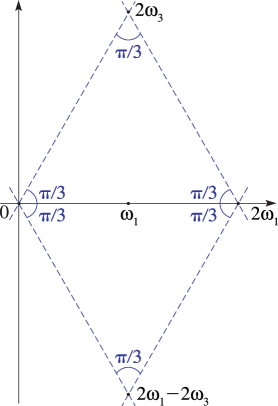§23.5 Special Lattices
Contents
- §23.5(i) Real-Valued Functions
- §23.5(ii) Rectangular Lattice
- §23.5(iii) Lemniscatic Lattice
- §23.5(iv) Rhombic Lattice
- §23.5(v) Equianharmonic Lattice
§23.5(i) Real-Valued Functions
The Weierstrass functions take real values on the real axis iff the lattice is fixed under complex conjugation: ; equivalently, when . This happens in the cases treated in the following four subsections.
§23.5(ii) Rectangular Lattice
This occurs when both and are real and positive. Then and the parallelogram with vertices at , , , is a rectangle.
In this case the lattice roots , , and are real and distinct. When they are identified as in (23.3.9)
| 23.5.1 | ||||
Also, and have opposite signs unless , in which event both are zero.
As functions of , and are decreasing and is increasing.
§23.5(iii) Lemniscatic Lattice
This occurs when is real and positive and . The parallelogram , , , is a square, and
| 23.5.2 | |||
| 23.5.3 | ||||
| 23.5.4 | ||||
Note also that in this case . In consequence,
| 23.5.5 | ||||
§23.5(iv) Rhombic Lattice
This occurs when is real and positive, , , and . The parallelogram , , , , is a rhombus: see Figure 23.5.1.
The lattice root is real, and , with . and have the same sign unless when both are zero: the pseudo-lemniscatic case. As a function of the root is increasing. For the case see §23.5(v).
§23.5(v) Equianharmonic Lattice
This occurs when is real and positive and . The rhombus , , , can be regarded as the union of two equilateral triangles: see Figure 23.5.2.
| 23.5.6 | |||
and the lattice roots and invariants are given by
| 23.5.7 | |||
| 23.5.8 | ||||
Note also that in this case . In consequence,
| 23.5.9 | ||||


